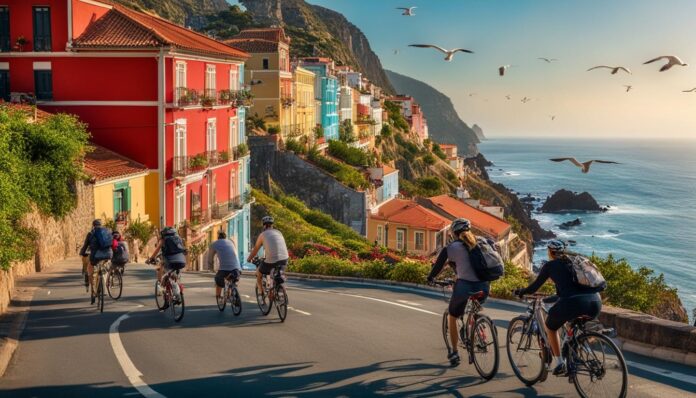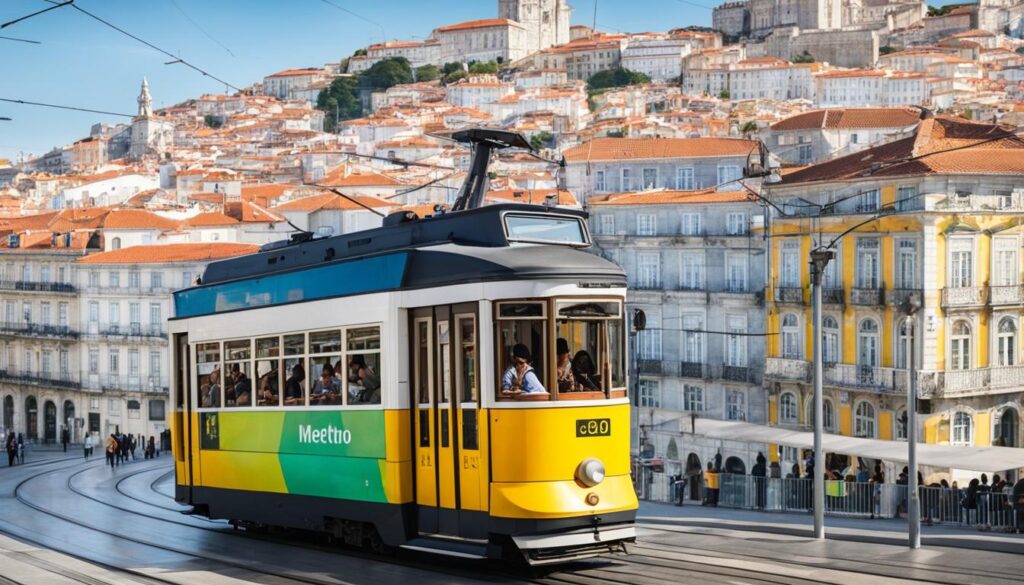Are you planning a trip to Portugal and wondering how to get around without a car? Fortunately, Portugal has an extensive transportation network that offers convenient alternatives to driving. Whether you prefer to travel by train, bus, or bike, there are plenty of transportation options in Portugal to help you reach your destination. In this section, we will explore eco-friendly transportation options and travel tips for convenient and efficient ways to navigate Portugal without relying on a car.
Public Transportation in Portugal
If you’re looking for alternative modes of transportation in Portugal, public transportation is a great option. Portugal has a well-developed and extensive public transportation network that can take you to major cities and towns across the country. The network includes buses, trains, trams, and metros. Let’s explore each of these public transportation options in detail.
Buses
Portugal’s bus system is a convenient and affordable way to travel within and between cities and towns. The main bus companies operating in Portugal include Rede Expressos, Eva Transportes, and Rodoviária do Tejo. You can purchase tickets online, at bus stations, or on the bus itself. The fares are generally inexpensive compared to other transportation options. The bus routes usually connect major cities and remote areas.
Trains
Train travel in Portugal is often an enjoyable and efficient way to explore the country. The main train provider in Portugal is Comboios de Portugal (CP). The CP offers both regional and high-speed trains that connect the major cities. Be sure to check the schedule and book your tickets in advance. One of the most popular scenic train routes is the Douro Valley train journey, which follows the winding Douro River through picturesque valleys and vineyards.
Trams and Metros
Portugal’s major cities, such as Lisbon and Porto, offer efficient tram and metro systems that make it easy for you to move around within the urban areas. The Lisbon tram system is an iconic attraction and operates in the historic parts of the city. The Porto metro covers most of the urban area and connects to the surrounding suburbs. Tickets can be purchased at stations and can also be recharged online.
Ticket Options
Most public transportation systems in Portugal offer multiple ticket options to meet different travel needs. You can purchase single tickets for a one-way journey, or multi-day or multi-trip tickets for longer stays. Train fares depend on the type of train service, so be sure to check your options. Please be reminded that discounts are often available for seniors, children, and students. Also, some cities offer passes for unlimited travel on public transportation. Check with local tourism offices for more information.
Navigating the Public Transportation System Effectively
The public transportation systems in Portugal can be a bit confusing for first-time users. But don’t worry, with a little preparation and planning, you’ll be able to navigate the system effectively. It’s a good idea to download the relevant apps for the system to stay up to date on schedules, maps, ticketing options, and connecting transportation methods. Be sure to arrive at the station early and allow plenty of time to purchase tickets and find the correct platform.
Exploring Portugal by Train
If you’re looking for an efficient and comfortable way to travel through Portugal, consider exploring the country by train. Portugal’s railway system is well-developed and provides numerous transportation options for travelers without cars. You’ll find a range of train services available, including high-speed trains, regional trains, and scenic routes that showcase Portugal’s stunning landscapes.
Trains in Portugal are an excellent option for exploring the country’s major cities and smaller towns, providing a convenient and affordable way to travel. The trains are also eco-friendly, making them a sustainable choice for getting around Portugal.
Types of Train Services in Portugal:
Portugal’s railway system offers different types of train services, each with its unique advantages. Here are some of the trains you can use to explore the country:
| Train Type | Description |
|---|---|
| Alfa Pendular | High-speed trains that connect major cities |
| Intercidades | Regional trains connecting major cities and smaller towns |
| Regional | Trains connecting smaller towns and villages |
| Scenic Trains | Trains offering breathtaking views of Portugal’s landscapes and coastlines |
Before planning your train journey in Portugal, it’s essential to consider the type of train service that best fits your travel needs.
How to Plan Your Train Journeys:
Planning your train journeys in Portugal is easy thanks to the various online resources available. The national railway company, Comboios de Portugal (CP), has an excellent website that provides information on train schedules, routes, and ticket prices.
When planning your train journey, be sure to consider the length of the trip, the type of train service, and the necessary connections. It’s also essential to book your tickets in advance to secure your seat and take advantage of any available discounts.
Exploring Portugal without a car is hassle-free with the country’s numerous transportation options, including train travel. Book your train tickets in advance, plan your journey using the available resources, and get ready for an unforgettable experience exploring the country’s stunning landscapes and charming towns.
Getting Around Portugal by Bus
Portugal’s vast network of buses offers an excellent alternative to driving yourself. Conveniently connecting major cities to remote areas, the public transportation system allows you to sit back and enjoy the scenery.
To navigate the bus system effectively, start by identifying the routes that align with your travel itinerary. Consult the local bus schedules to plan your journeys, ensuring you’re aware of the frequency of the buses and the time of the day they operate. Consider purchasing a ticket pass that suits your needs and budget.
Popular bus routes include the famous Lisbon to Porto route, which boasts of beautiful scenery including forests, mountains, and wine regions. Another popular route is Fátima to Nazaré which attracts religious pilgrims and beach-loving travelers alike.
When traveling outside of major cities, be sure to have cash on hand, as some remote areas might only accept payments in cash. It would be best to check the payment options ahead of time with the local bus authorities.
In conclusion, getting around Portugal by bus is a convenient and affordable way to explore the country. Plan your trip in advance, familiarize yourself with the schedules, and purchase a suitable ticket for your travel needs to make the most of this public transportation mode.
Tram and Metro Systems in Portugal
When exploring Portugal’s major cities like Lisbon and Porto, trams and metros offer efficient and convenient public transportation options. Using these systems effectively can help you move around urban areas quickly and affordably.
Most cities in Portugal have a modern metro system that is easy to use. In Lisbon, the metro network has four different lines and serves neighborhoods across the city, including the airport. Porto has a similar metro system with six lines and offers connections to the suburbs and nearby cities.
To use the metro, purchase a rechargeable card called “Viva Viagem” and add fares according to your itinerary. You can obtain it at any of the ticket machines or ticketing offices that are at every metro station. The metro system in Lisbon is open from 06:30 in the morning until 01:00 the following day. On Fridays, Saturdays, and nights before public holidays, it stays open until 02:00 in the following morning.
Most cities in Portugal like Lisbon and Porto also offer tram services that serve specific routes and areas. Although trams may be slower than the metro, they make for a scenic and enjoyable ride, particularly for tourists exploring different parts of a city.
The tram systems in both Lisbon and Porto are convenient for reaching popular tourist hotspots. In Lisbon, Tram 28 is a famous attraction that takes riders on a slow-paced journey through the city’s historic neighborhoods. Additionally, the Riverside Tram offers a beautiful view of the Tagus River from Lisbon’s southern coast.
Overall, Portugal’s efficient metro and tram systems offer practical and enjoyable ways to travel throughout the cities. Make sure to plan your trip accordingly, taking into account different ticketing and route options.
Cycling in Portugal
If you’re looking for an eco-friendly way to explore Portugal, cycling is a great option. There are many scenic roads and bike paths throughout the country that offer amazing views of charming towns and breathtaking landscapes.
To get started, you can rent bikes from various rental services available in Portugal, such as Bike Iberia or Oporto Bikes. These services offer bike rentals for a day or longer, and some include delivery and pick-up services from your accommodation.
When planning your cycling route, take into account your fitness level, the terrain, and weather conditions. There are many cycling routes available throughout the country, including the Ecovia do Litoral along the coast and the Ecopista do Dão in central Portugal.
It’s important to stay safe while cycling in Portugal. Make sure to wear a helmet and reflective clothing, follow traffic rules, and use bike lights at night. Take care when cycling on rural roads and be aware of local wildlife.
Bike Rental Services
| Rental Service | Location | Rental Rates |
|---|---|---|
| Bikeiberia | Lisbon, Alentejo, Algarve | $15-35 per day |
| Oporto Bikes | Porto and surrounding areas | $15-25 per day |
| Portugal Bike | Cascais, Sintra, Lisbon | $25-35 per day |
Cycling in Portugal is a unique and rewarding way to explore the country’s natural beauty and charming towns. With a variety of rental services available and scenic routes to choose from, it’s an adventure you won’t forget.
Walking and Hiking in Portugal
If you’re someone who loves exploring new places on foot, Portugal has much to offer. From awe-inspiring landscapes to urban adventures, the country has numerous walking and hiking trails waiting to be explored.
Popular Trails and National Parks
In Portugal, walking and hiking trails are available throughout the country. The Rota Vicentina is one such popular trail that runs along the western coast of Portugal. The trail spans over 450 kilometers and offers picturesque views of the Atlantic Ocean. National Parks such as the Peneda-Geres National Park and the Arrabida Natural Park have numerous walking trails and scenic routes for nature lovers.
Safety Precautions and Equipment
Before embarking on your walking or hiking adventure, it’s important to take necessary safety precautions. Always carry plenty of water and snacks to keep yourself hydrated and energized. Wear comfortable footwear with good grip to avoid slipping. Additionally, it’s wise to bring sunscreen, a hat and other protective gear, especially if you’re hiking in the warmer months.
Best Times to Go Walking and Hiking
Walking and hiking can be enjoyed year-round in Portugal. Spring (March through May) and Fall (September through November) are usually considered the best times to go walking and hiking as the temperatures are milder, and the crowds are relatively smaller. Summer (June through August) is the peak tourist season in most parts of Portugal and can be quite hot, making it a less popular season for outdoor activities.
Ferries and Boat Transport in Portugal
If you’re looking for a unique way to explore Portugal’s coastal regions and islands, ferries and boat transport are excellent options. Portugal’s strategic location on the Atlantic coast provides plenty of opportunities to explore picturesque coastal towns and islands like the Azores and Madeira.
Discover the best ways to explore the coast and islands of Portugal without a car:
| Ferry Company | Route | Schedule |
|---|---|---|
| Atlantico Line | Azores | Regular sailings from several Portuguese ports |
| Porto Santo Line | Madeira | Daily sailings from Funchal and Porto Santo |
| Naviera Armas | Canary Islands | Regular sailings from Lisbon and Portimão |
For exploring the coastal towns, boats provide scenic sightseeing opportunities, such as going on a day trip to Cascais from Lisbon. Discover the best options for ferries and boat transport and plan your island-hopping adventures.
Renting Bikes and Scooters in Portugal
If you’re looking to add a little thrill to your travel experience in Portugal, consider renting a bike or scooter to get around. Not only is it a fun way to explore, but it’s also an eco-friendly option that allows for greater flexibility in your schedule.
There are several rental options available throughout the country, including bike rental services and scooter rental companies. Rates vary depending on the type of bike or scooter you choose, the rental duration, and the location.
It’s important to note that you’ll need to wear a helmet while riding a bike or scooter in Portugal. Some rentals may include a helmet in the price, while others may require an additional fee. Safety guidelines should be followed at all times to ensure a smooth and enjoyable ride.
Whether you’re navigating the narrow streets of Lisbon or cruising along the beaches of the Algarve, bikes and scooters offer a fun and convenient way to explore Portugal without a car.
Benefits of Renting Bikes and Scooters
- Greater flexibility in your travel schedule
- Eco-friendly and sustainable transportation option
- Opportunity to explore regions not accessible by public transportation
- Affordable and budget-friendly compared to other modes of transportation
- Fun and unique way to experience Portugal’s natural beauty and culture
Tips for Renting Bikes and Scooters in Portugal
- Research rental companies and compare rates and services
- Make sure the bike or scooter is in good condition before renting
- Understand the rules of the road and follow traffic laws
- Check if the rental includes a helmet or if you need to bring your own
- Be mindful of parking regulations and secure your bike or scooter when leaving it unattended
Using Ride-Sharing and Taxi Services
When you need to get around Portugal without a car, ride-sharing services and taxi firms offer a convenient and efficient mode of transportation. Popular ride-sharing apps such as Uber and Bolt operate throughout the country, allowing you to book affordable and comfortable rides at your convenience. Some taxi companies may also offer additional services such as airport transfers, city tours, and private tours of local attractions.
To get started with ride-sharing services, simply download the app on your smartphone, enter your pick-up and drop-off locations, and choose your preferred ride. Payment can be done through the app, making it a hassle-free experience. Taxi services can also be booked in advance or hailed on the street. Be aware of scams, and only use official taxis with licensed drivers.
When using ride-sharing and taxis to get around Portugal, it is important to keep in mind peak times, traffic conditions, and local customs. If traveling during rush hour or in busy areas, be prepared for longer wait times and higher fares. Communicating your destination clearly to your driver and confirming the fare in advance can help prevent any misunderstandings.
“I took a ride on Uber from my hotel to the castle, it was convenient, the driver was friendly and gave me some recommendations for local restaurants.”
The Advantages of Using Ride-Sharing and Taxi Services
- Ride-sharing and taxi services are available day and night, making them a flexible and convenient option for travelers.
- You can book rides in advance or on the spot, giving you freedom and ease of travel.
- With clear pricing and payment options, you can avoid the hassle and confusion of dealing with foreign currency or haggling with drivers.
- Taxi services are licensed, ensuring your safety and quality of service while on the road.
Overall, utilizing ride-sharing and taxi services is a valuable and efficient way to get around Portugal during your trip. Make sure to research and compare different providers before making your booking, and always practice safe and responsible travel habits while using these services.
Conclusion
If you’re traveling to Portugal and looking for efficient ways to get around without a car, there are plenty of options available. From the extensive public transportation network that connects major cities and towns to walking and cycling routes that allow you to explore the natural beauty of the country, you can navigate Portugal easily.
Consider renting a bike or scooter to add flexibility to your travel plans, and use ride-sharing apps and taxis to maximize your convenience. With these travel tips for getting around Portugal, you can experience the charm of the country in an eco-friendly and efficient manner. So pack your bags, and explore Portugal without the hassle of driving a car!

















































